Exploring Florida’s Conch Shells
What Are Conch Shells?
Conchs aren’t just ordinary sea shells. They are an amazing blend of biology and natural artistry. Found in warm tropical waters, these shells are made by sea snails from the Strombidae family. Conch shells have a unique spiral shape that has fascinated people for centuries.
How Conch Shells Are Made
From Egg to Shell
The journey of a conch shell starts when the conch snail hatches from its egg. As the snail grows, it secretes calcium carbonate, which hardens over time to form its shell. The size and shape of the shell change as the snail grows, creating beautiful patterns and colors. Each conch shell is unique.
The Role of Conchs in Culture
Historical Significance
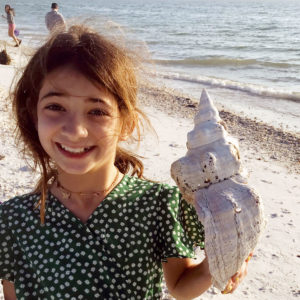
The Making of Conch Shells
Biological Formation of Conch Shells
Biomineralization Process
The creation of a conch shell is called biomineralization. The conch snail’s mantle, a special tissue, secretes calcium carbonate. This forms aragonite crystals that interlock to create a hard structure. Over time, layers are added, forming a beautiful spiral shape.
Factors Affecting Shell Shape and Size
The shape and size of a conch shell are influenced by genetics and the environment. Diet, water temperature, and salinity affect the shell’s growth and color. This makes each shell unique.
Importance of Calcium Carbonate
Building Strong Shells
Calcium carbonate is the main ingredient in conch shells and rocks like limestone and marble. The snail’s mantle arranges aragonite crystals to make the shell strong and resistant to breakage, which helps protect the snail from predators.
More Than Just Structure
Calcium carbonate also helps regulate the snail’s internal environment, maintaining ionic balance and overall health. This shows how a simple compound can have complex functions in marine life.
Growth Process of the Conch
Starting Small
The conch snail starts with a tiny shell called a protoconch. As the snail grows, its mantle adds layers to the shell, creating the spiral shape we recognize.
Growth and Environment
The snail’s growth rate depends on water temperature, food availability, and overall health. In good conditions, growth is rapid early on but slows as the snail ages. The shell also forms growth lines, similar to tree rings, which can tell us about the snail’s age and life conditions.
Colors and Patterns
The shell’s colors and patterns are influenced by the snail’s diet and the minerals in the water. This results in a variety of beautiful shells.
Environmental Factors Influencing Shell Formation
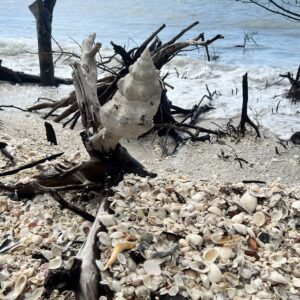
Florida Horse Conch shell on a shell island near Marco Island
Important Factors
- Water Temperature
Conch snails need warm, tropical waters for shell growth. Higher temperatures help them produce calcium carbonate efficiently. - Salinity
The right salinity levels are crucial. High salinity promotes shell formation, while low salinity can weaken the shells. - Nutrients
A diet rich in calcium is essential for shell growth. Conch snails feed on algae and other marine organisms. - Water Quality
Clean water is vital. Pollutants can harm the snail’s ability to grow its shell properly. - Ocean Currents and Waves
In areas with strong currents, snails may develop thicker shells. Calmer waters result in thinner shells. - pH Levels
Ocean acidification is a concern. Lower pH levels can dissolve calcium carbonate, making shell growth difficult.
Uses and Significance of Conch Shells
Cultural Importance
- Spiritual and Ceremonial Use
In Hinduism, the conch shell is sacred and used in rituals. In Buddhism, it represents the spread of teachings. - Musical Use
Conchs have been used as wind instruments in various cultures. They produce a deep, resonant sound. - Practical Use
Ancient civilizations made tools, ornaments, and currency from conchs. They are durable and beautiful.
Ecological and Economic Importance
- Habitat and Shelter
Conch shells provide homes for hermit crabs, small fish, and algae, enhancing marine biodiversity. - Economic Value
The queen conch’s meat is a delicacy, supporting local economies. Sustainable practices are essential to protect conch populations.
Conch Shells Found in Florida
Common Types of Conch Shells
Florida is home to various conch shells thanks to its warm tropical waters. Here are some of the most common types you might encounter:
Horse Conch (Triplofusus giganteus)
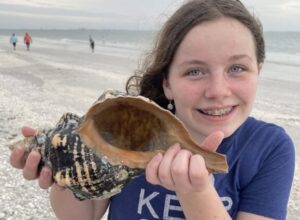
The Horse Conch is the largest gastropod in the Americas, up to 24 inches long. It has a striking orange interior and a long, spiraled shell.
Habitat
They are found in sandy, muddy, and seagrass areas in both shallow and deeper waters.
Significance
Despite its name, the Horse Conch is not a true conch but is related. Its impressive size and vibrant color make it a prized find for collectors.
Queen Conch (Strombus gigas)
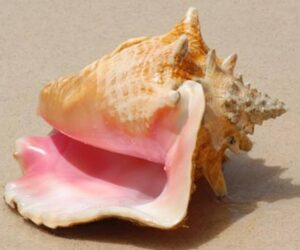
The Queen Conch is one of the largest and most iconic conch shells. It can grow up to 12 inches long and has a beautiful pink interior.
Habitat
They are found in seagrass beds and sandy areas of shallow waters.
Significance
Queen Conchs are not only admired for their shells but also valued for their meat, which is a delicacy in many cuisines.
Florida Fighting Conch (Strombus alatus)

This conch has a sturdy, thick shell that ranges in color from light brown to deep orange. It typically grows up to 4 inches long.
Habitat
They prefer shallow waters with sandy or muddy bottoms and are often found near seagrass beds.
Significance
Named for their aggressive behavior when threatened, these conchs are fascinating to observe in their natural habitat.
Crown Conch (Melongena corona)
Appearance
The Crown Conch has a spiky, crown-like appearance. It is usually dark brown or black and can grow up to 5 inches long.
Habitat
They are commonly found in mangrove swamps, estuaries, and tidal flats. They are typically easier to find in brackish areas than saltwater.
Significance
These conchs play an important role in the ecosystem by controlling the population of their prey.
Hawkwing Conch (Strombus raninus)
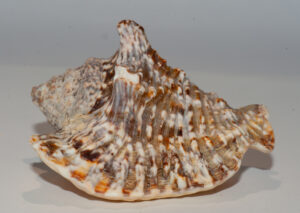
The Hawkwing Conch has a distinctive shell with long, wing-like extensions. It is smaller than the Queen Conch, usually around 5 inches long.
Habitat
They are found in sandy and seagrass areas in shallow waters.
Significance
Their unique shell shape makes them a popular find among shell collectors.
Milk Conch (Strombus costatus)
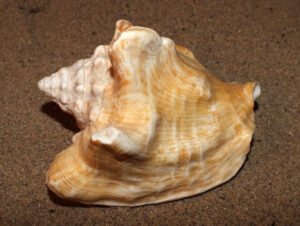
The Milk Conch has a smooth, thick shell that is usually pale or milky in color. It can grow up to 6 inches long.
Habitat
They inhabit shallow waters with sandy or muddy bottoms, often near coral reefs.
Significance
Milk Conchs are known for their distinctive coloring and smooth texture.
Explore Conch Shells
Join us for an eco-tour to explore the amazing world of conch shells. Book your shelling tour online and experience the beauty of Marco Island and the 10,000 Islands firsthand!




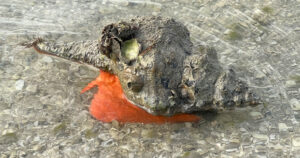
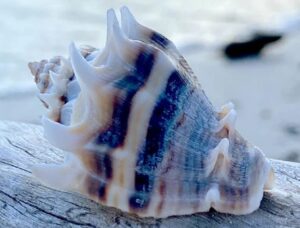








Join the discussion One Comment